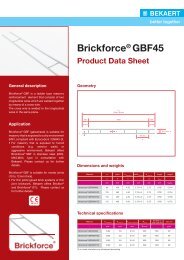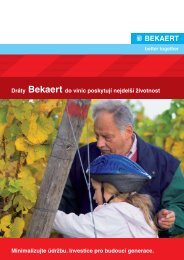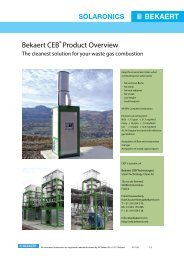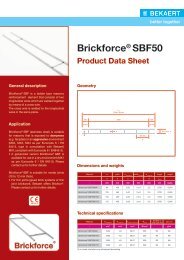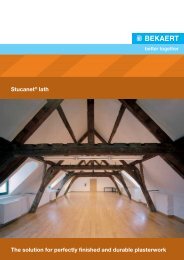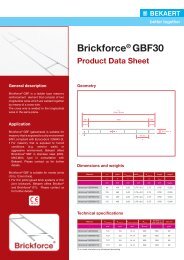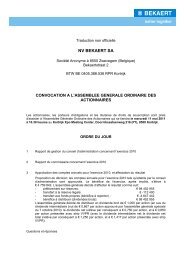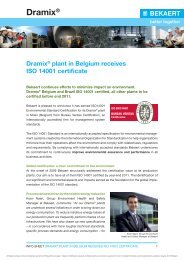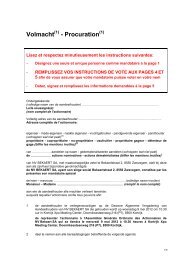Bezinal Voltage 32luik - Bekaert
Bezinal Voltage 32luik - Bekaert
Bezinal Voltage 32luik - Bekaert
You also want an ePaper? Increase the reach of your titles
YUMPU automatically turns print PDFs into web optimized ePapers that Google loves.
Operating the conductor at higher<br />
temperatures increases power grid<br />
capacity<br />
Whereas in the past electricity production<br />
has been strongly localised in the<br />
area where it is consumed, the current<br />
trend to buy electricity where it is cheapest<br />
strongly increases transport over<br />
large distances, using the existing networks.<br />
The result is that the installed capacity<br />
of high voltage power lines is getting<br />
insufficient. Economic and ecological<br />
objections prevent the building of new<br />
lines in many places.<br />
The only solution is<br />
significantly increasing<br />
the capacity of existing<br />
lines, i.e. increasing<br />
line capacity.<br />
Capacity (MVA)<br />
P 250°C<br />
2x<br />
P 50°C<br />
As a consequence, more heat is generated<br />
(heat generation increases quadraticly<br />
with current), causing the nominal<br />
operating temperature to rise from 50°C<br />
up to even 300°C.<br />
Existing power grids are typically equipped<br />
with traditional ACSR or AAAC conductors,<br />
which are not suitable for operation<br />
at these high temperatures.<br />
Therefore, ACSS and T-ACSR conductors<br />
have been developed.<br />
50 100 150 200 250<br />
Temperature of the conductor (°C)<br />
Different conductor types<br />
ACSR:<br />
Aluminium<br />
Conductor Steel<br />
Reinforced<br />
The conductor consists<br />
of steel wires around<br />
which hard-drawn 1350<br />
aluminium wires are<br />
wound. Both the steel<br />
core and the aluminium<br />
wires mechanically<br />
support the conductor.<br />
ACSS:<br />
Aluminium<br />
Conductor Steel<br />
Supported<br />
ACSS and ACSR are<br />
similar from a geometric<br />
point of view. The<br />
ACSS is annealed in the<br />
factory. The main aim is<br />
to permanently soften<br />
the hard-drawn 1350<br />
aluminium wires. In all<br />
operating conditions the<br />
ACSS is only supported<br />
by the steel.<br />
AAAC:<br />
All Aluminium Alloy<br />
Conductor.<br />
A drawn and age-hardened<br />
6201 aluminium<br />
alloy yields a considerably<br />
higher mechanical<br />
strength than the pure<br />
1350 aluminium. No<br />
steel is needed for supporting<br />
the conductor.<br />
T-ACSR:<br />
Temperature<br />
resistant Aluminium<br />
Conductor Steel<br />
Reinforced<br />
The conductor is similar<br />
to an ACSR, except that<br />
the aluminium is alloyed<br />
with zirconium (Zr),<br />
which prevents the<br />
mechanical properties<br />
of the drawn aluminium<br />
to change irreversibly at<br />
elevated temperatures.<br />
Determining design parameters:<br />
sag and safety limit (force)<br />
Two design parameters determine the applicability<br />
of a conductor (technical constraints related to<br />
the towers are not considered): the sag and the<br />
force required to keep the conductor in the air.<br />
The maximum allowable force for a conductor<br />
corresponds typically with one third of the yield<br />
strength. Relating the applied force<br />
to the yield strength is straightforward<br />
(force = strength<br />
60<br />
x cross section of the supporting<br />
area of the conductor).<br />
50<br />
The maximum allowable sag is often<br />
related with local (legal) restrictions.<br />
40<br />
Force<br />
Wind load<br />
Definition of sag and force<br />
applied force (kN)<br />
Sag<br />
30<br />
20<br />
10<br />
Own weight<br />
and ice load<br />
The sag is often expressed in terms of the radius,<br />
typically 1600 m. This value (excl. external<br />
load) is the starting point for further calculations.<br />
Other constants are: a span of 400 meter, external<br />
load of about 500 kg, (conductor geometry =<br />
Hawk (ASTM) or equivalent).<br />
Force<br />
15 20 25<br />
sag/m<br />
For a constant temperature, the<br />
sag is function of the total load<br />
(conductor weight, ice and<br />
wind load) and the modulus of<br />
elasticity of the supporting<br />
metal (typically 200 GPa for<br />
steel and 70 GPa for aluminium).<br />
When the sag decreases, the<br />
force increases substantially.<br />
Influence of temperature<br />
on the mechanical<br />
properties<br />
When determining the sag at elevated temperatures<br />
(Operating temperatures up to 300°C are<br />
taken into consideration), we need to consider:<br />
- the thermal expansion coefficient of the different<br />
metals (typically 12 µm/m°C and 25<br />
µm/m°C for the used steel and aluminium grades,<br />
resp.)<br />
- the temperature dependence of the different<br />
metals’ elasticity modulus. The temperature<br />
related changes of the modulus are reversible.<br />
The yield strength –and hence the “safe operation<br />
limit” corresponding with 1/3 of the yield<br />
strength- decreases with temperature. In contrast<br />
with the modulus of elasticity, temperature induced<br />
changes of the yield strength are almost completely<br />
irreversible for the hard-drawn 1350 aluminium<br />
in ACSR and the 6201 aluminium alloy in<br />
AAAC, thanks to recrystallisation and over-aging<br />
effects. After heating to 300°C, both alloys will<br />
have mechanical properties similar to those of<br />
annealed 1350 aluminium. The yield strength of<br />
zirconium-alloyed aluminium used for T-ACSR<br />
conductors is reversibly changing up to a certain<br />
temperature. This temperature depends on the<br />
amount of zirconium in the alloy. It is typically<br />
180°C for standard grades and 250°C for high<br />
grades with more zirconium. The temperature<br />
induced change in yield strength of the steel will<br />
be reversible.<br />
BEKAERT<br />
3





